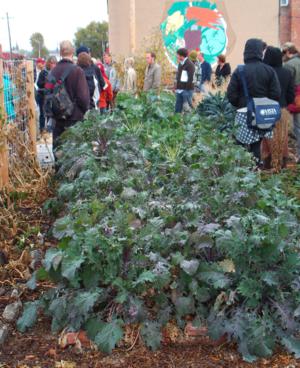What if I told you that you did not have to pull every weed, sweating under the hot sun with a sore back and little yield? Permaculture refers to permanent agriculture, a system to stack functions and work with nature (by first observing) instead of fighting against it all of the time! Get a quick permaculture overview through the contrast of two city lots, side-by-side.
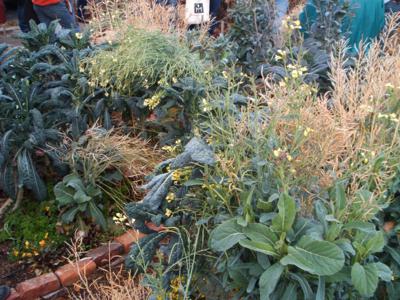
What is Permaculture? The practice of Permaculture centers around three ethics, however in practice we are not looking to add anything new, just rearrange existing components for a more robust complementary system. Here is an example: are your leaves turning yellow? It’s most likely a nitrogen deficiency, so plant some comfrey—which will create a hedge of sorts to discourage animals from entering the space, enrich the soil with a lot of nitrogen, and serve as a potential medicinal herb source for your family. Partnering plants in certain ways increases the habitat for animals, life, and microbes that increase the productivity of your soil.
A Permaculture course (also known as a PDC or Permaculture Design Course) teaches a variety of techniques that drastically reduce your workload, by letting nature drive—but first you have to observe. Learning alternatives to weed-pulling and tilling can actually increase your yield and undisputedly improve the quality and flavor of what you produce.
Rather than simply taking my word for it, let us compare two city lots in Spokane, WA while getting a tour during the Inland Northwest Permaculture Conference this past weekend (Nov 2011). Everyone first met up at the One World Spokane restaurant. The first adventure was literally on the other side of the back door, which is another Permaculture principle, “start at your door”. The restaurant hosts a community garden that contrasted the surrounding neighborhood in a very demonstrative way. Keep in mind, these garden pictures were taken during the first week in November in Washington State. I wish I could show you the July beauty and production value—and yet perhaps there is no clearer indicator of the endless possibilities to this gardening style when you see the beauty and production levels weeks after the arrival of frost.
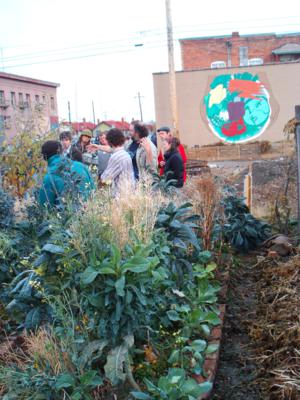
We saw red strawberries still in the patch (ours were over months ago), we saw tomatoes that were harvested as late as mid-October. There were vining plants on the fence, lettuces, kale, and a variety of other greens.
“Skeeter” (Michael Pilarski) led the tour through the Permaculture garden, explaining the community’s involvement to make a peaceful and productive space in an urban setting. We saw red strawberries still in the patch (ours were over months ago), we saw tomatoes that were harvested as late as mid-October. There were vining plants on the fence (using vertical space is another Permaculture principle), lettuces, kale, and a variety of other greens.
This is where things changed for me. Skeeter told us to stop looking at the garden to which our eyes were drawn and to survey the surrounding area. The crowd grew silent.
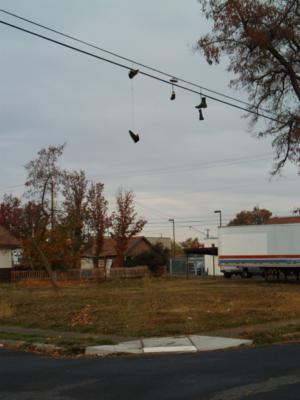
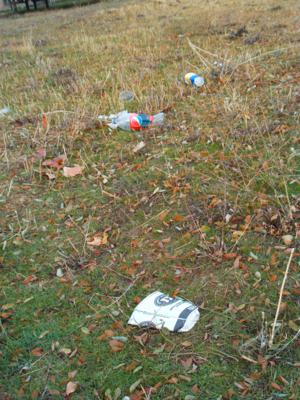
Up until now it had been largely an academic discussion about an urban garden with a few new twists, however this is where things changed for me. Skeeter told us to stop looking at the garden to which our eyes were drawn and to survey the surrounding area which included a much larger empty lot right across the street. The crowd grew silent. “What would you do to change this?” he asked. He pointed to a defunct fire escape and asked, “Any ideas?” Someone mentioned (bee friendly) flower boxes, another mentioned vining legumes as a food garden to hide the harsh steel. He pointed to the broken sidewalks and vacant lots. Ideas began flowing and excitement grew as we now envisioned lush food and flower production, the re-entrance of valuable insects (spiders, honey bees, and so forth), and improved soil conditions. What would that do for the people living here? What would it mean to have local food sources, independence, and beauty? What would it benefit the youth, to have a constructive and productive environment changed with deliberate Permaculture designs such as what we could now see?
This is the tale of two city lots.
Again, the garden’s images are from what is normally considered the “wrong” time of year. If this permaculture overview peaked your interest, then I recommend Paul Wheaton’s work at RichSoil.com or you can get the interactive experience at the forums over at Permies.com. There certainly are not any silver bullets in food production, however the Permaculture movement has gained a lot of traction from the results they have been able to prove with this system of design. Permaculture designs via the three Permaculture ethics are what constitutes the paradigm in practice.
Chaya
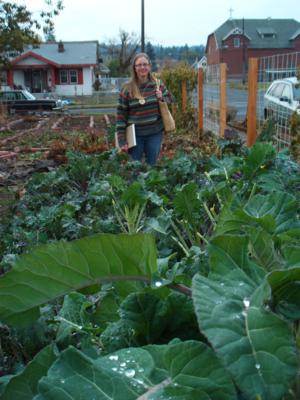
Photo Credits:
All photos by Pantry Paratus

